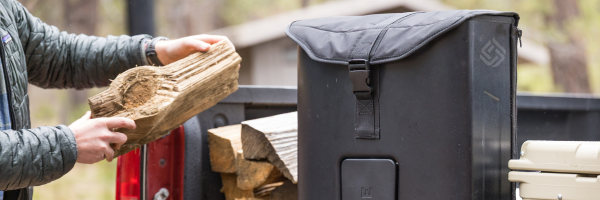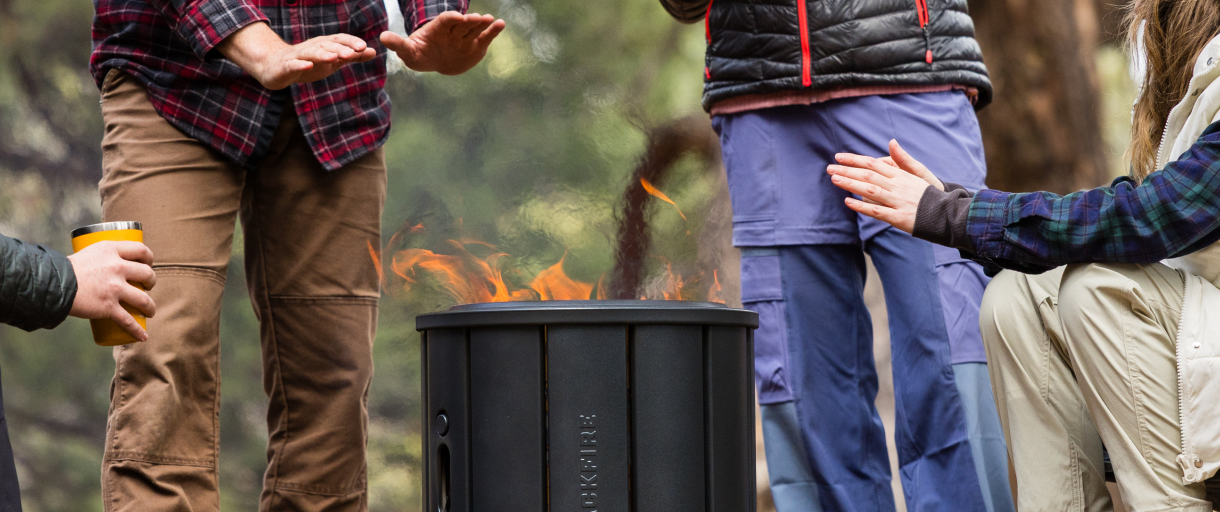PACKFIRE Blog
How to Clean a Fire Pit + 6 Pro Tips
There’s something magical about gathering around a fire pit. The crackle of wood, the warmth on a crisp evening, friends swapping stories while marshmallows roast just right… But then the flames die down, and suddenly you’re staring at a pile of ash, soot, and maybe even a hint of rust forming on your stainless steel or cast iron fire pit.
Whether you’re tending a wood-burning fire pit, a propane fire pit, or a compact option like PACKFIRE’s portable fire pit, a little attention now means cleaner, hotter flames later.
Key Takeaways
-
Regular cleaning keeps your outdoor fire pit lasting longer and helps prevent rust.
-
Always make sure your fire pit has cooled completely before touching it.
-
Use hot soapy water and a soft cloth, or steel wool for stubborn spots.
-
Gas fire pits need extra care, including checking gas lines.
-
Covers and proper storage protect all kinds of fire pits—stainless steel, cast iron, or steel fire pits.

Step 1: Safety First! Let It Cool Completely
Before touching anything, make sure your fire pit has cooled completely. Hot embers or residual flames can be dangerous. If you’re working on a gas fire pit, turn off the propane, disconnect the gas lines, and let it settle. For wood-burning pits, let the ashes cool completely before removing anything.
Pro Tip: Pour a small amount of water over stubborn coals to help them cool faster, but be careful. Too much water can create steam or scorch nearby surfaces.
Step 2: Remove Ashes and Debris
Once the pit is cold, grab a scoop or small shovel and remove ashes, leftover logs, and debris.
For metal fire pits, including those made of steel and cast iron, removing ashes as soon as possible helps prevent moisture from collecting and causing rust. And no one wants that! A gentle brush can help loosen small fragments stuck to the bottom or sides.
Step 3: Scrub the Interior and Exterior
Next comes the scrubbing. A mix of hot soapy water and a soft cloth works well for most surfaces. For tougher spots on stainless steel or steel fire pits, gently use steel wool, just enough to lift residue without scratching. PSA to PACKFIRE owners: Do NOT use anything abrasive, such as steel wool, on the aluminum exterior.
For gas fire pits, extra care is needed. Avoid getting water in the gas lines and carefully wipe burners to prevent buildup that could interfere with flames. Keeping surfaces shiny and rust-free ensures that your next fire ignites easily and burns evenly.
Step 4: Dry and Inspect
Make sure all soap residue is removed and dry everything thoroughly to prevent rust. Use a soft towel, then let it air-dry completely. While you’re at it, check for small rust spots, cracks, or loose parts. If you have a propane fire pit, inspecting the gas lines is essential for safety and efficient heat output.
Step 5: Optional Deep Clean for Extra Sparkle
If you want to go the extra mile to make your fire pit last longer, here’s a deep cleaning routine:
-
Metal Fire Pits & Steel Fire Pits: Lightly polish with metal cleaner for shine. If they’re a bit older and worn, check for rusty charred edges and lightly sand them smooth if needed.
-
PACKFIRE’s Aluminium exterior: For a shiny finish, some people lightly coat aluminum with a food-safe oil or automotive aluminum polish. It’s not necessary for durability, but it can make your pit look new longer.
-
Cast Iron Fire Pits: Apply a thin layer of cooking oil to keep moisture out and protect against rust.
-
Gas Fire Pit Burners: Use a dry toothbrush to remove debris from jets and holes.
It only takes a few extra steps to keep your fire pit looking and performing like new every time, so we recommend doing a deep clean every 3-5 uses.
Step 6: Cover and Store
A fire pit cover is a simple investment that saves hours later. It shields your pit from rain, snow, and stray leaves. For portable setups like PACKFIRE’s fire pit that fits in its backpack, folding it and storing it in its bag keeps it safe, compact, and adventure-ready for the next time you hit the road.
Expert Fire Pit Maintenance Tips: Secrets Only Pros Know
You’ve cleaned your fire pit, scrubbed it shiny, and stored it under a cover, but if you really want it to last, there are a few little-known tricks that separate casual fire-lighters from true fire pit pros.
#1 Preheat Before Cleaning Aluminum or Stainless Steel
Ever noticed stubborn ash or soot clinging to your metal fire pit? Professionals will tell you that a quick preheat before scrubbing makes life easier. Light a small fire for 5–10 minutes, let it burn just enough to loosen residue, then let it cool completely. Scrubbing afterwards takes far less effort, and you avoid accidental scratching by softening hardened deposits first.
#2 Layer Your Ash Strategically
Don’t just dump ashes into a bucket. Some experts save a small layer of fine, cooled ash at the bottom of a wood-burning fire pit. Why? That thin layer acts as a natural insulator, protecting the metal from extreme heat swings and slowing oxidation—especially for steel and cast iron fire pits.
#3 Check for Micro-Cracks in Welds and Burn Chambers
Even a new fire pit can develop tiny stress fractures over time. Using a bright flashlight, inspect welds, the burn chamber, and gas line connections. Micro-cracks may look insignificant, but they can grow under repeated thermal cycling, causing weak spots or leaks in propane fire pits. Catching them early can save serious repairs later.
#4 Reverse Airflow Trick for Cleaner Metal
Here’s a pro tip for stainless steel and aluminum fire pits: once the pit is cooled, gently blow air from the opposite side of the vent system (use a leaf blower on low or compressed air). This shakes loose ash lodged in airflow channels and prevents clogs that can limit efficiency next time you light a fire.
#5 Spot Treat Rust Before It Spreads
For steel fire pits or cast iron, most people sand the rust and call it a day. Experts go further: after sanding, wipe the area with vinegar or a baking soda paste, rinse, dry completely, then apply a thin coat of high-temp fireproof paint or cooking oil to seal the metal. This creates a chemical barrier that slows future rust faster than simple sanding.
#6 Gas Pit Line Flush
For propane fire pits, many users forget about residue inside gas lines. Once a season, disconnect and lightly blow compressed air through the lines to remove accumulated dust, spider webs, or creosote particles. A clean line guarantees smoother ignition and avoids dangerous flare-ups.
#6 Keep the Base Elevated Off the Ground
Even for portable setups, always store your pit slightly elevated with bricks, stones, or a small stand. Ground moisture is sneaky. It creeps into steel pits, aluminum edges, or welded joints, accelerating corrosion over time. Yes, even stainless steel benefits from this trick. (Luckily, PACKFIRE is an elevated fire pit with no need to worry about this!)

Fire Pit Cleaning FAQ
How often should I clean my outdoor fire pit?
For wood-burning fire pits, clean after every use to remove ash and debris. Gas fire pits require a lighter cleaning schedule, approximately every 3 uses, but check the burners' integrity before and after every use.
Can I use water to clean my fire pit?
For cleaning, anytime! For putting out coals and flames, small amounts over cooled ashes to avoid steam or splatter. Never add water to a hot pit.
What’s the best way to prevent rust on a metal fire pit?
Dry it thoroughly after each cleaning, cover it when not in use, and store it off the ground if possible. Occasional oiling helps, especially for cast-iron fire pits.
What’s the safest way to clean a gas fire pit?
Turn off the propane, disconnect the gas lines, and once cooled, clean the burners gently. Avoid letting water come into contact with the gas connectors.
Can I use steel wool on my fire pit?
Yes, but only on stainless steel or steel fire pits. Use gentle pressure to lift residue without scratching.
Do I need a cover for my fire pit?
Absolutely. A fire pit cover protects against weather, debris, and moisture, reducing maintenance and prolonging life.

Final Thoughts on How to Clean a Fire Pit
Cleaning your fire pit might feel like a chore, but it’s one of those small rituals that make every future fire feel effortless and cozy. Whether it’s a metal fire pit or something compact like PACKFIRE’s flat-folding fire pit, keeping it well-maintained and properly stored prevents rust, protects your investment, and guarantees that your next night under the stars is as magical as the first.





